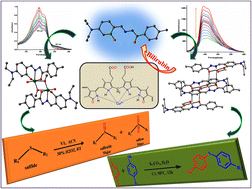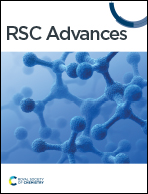Polymeric copper(ii) and dimeric oxovanadium(v) complexes of amide–imine conjugate: bilirubin recognition and green catalysis†
Abstract
An exceptionally simple amide–imine conjugate, (E)-N′-(4-(diethylamino)-2-hydroxybenzylidene)-4-methylbenzohydrazide (L), derived by the condensation of 4-methyl-benzoic acid hydrazide (PTA) with 4-(diethylamino)-2-hydroxybenzaldehyde was utilized to prepare a dimeric oxo-vanadium (V1) and a one-dimensional (1D) copper(II) coordination polymer (C1). The structures of L, V1 and C1 were confirmed by single crystal X-ray diffraction analysis. The experimental results indicate that V1 is a promising green catalyst for the oxidation of sulfide, whereas C1 has potential for a C–S cross-coupling reaction in a greener way. Most importantly, C1 is an efficient ‘turn-on’ fluorescence sensor for bilirubin that functions via a ligand displacement approach. The displacement equilibrium constant is 7.78 × 105 M−1. The detection limit for bilirubin is 1.15 nM in aqueous chloroform (chloroform/water, 1/4, v/v, PBS buffer, and pH 8.0).



 Please wait while we load your content...
Please wait while we load your content...